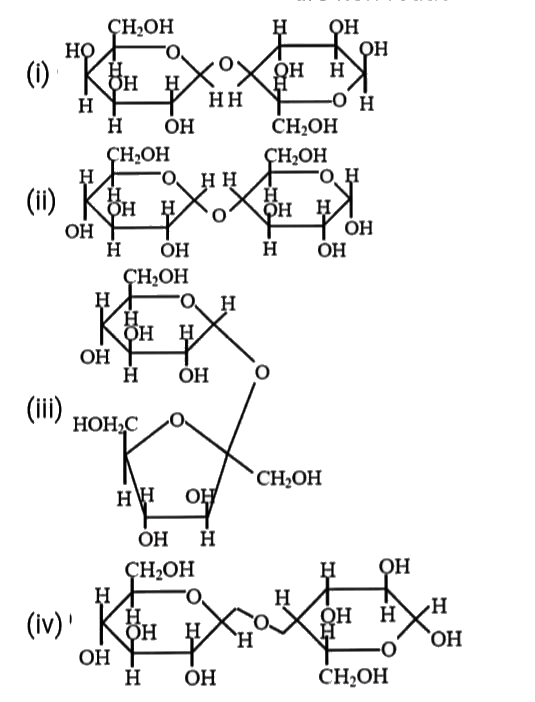Which of the following is non-reducing sugar ?
Glucose
Sucrose
Maltose
Lactose
The correct Answer is:B
To determine which of the following sugars is a non-reducing sugar, we need to understand the concept of reducing and non-reducing sugars.
Step 1: Understanding Reducing and Non-Reducing Sugars
- Reducing sugars are sugars that can be oxidized by mild oxidizing agents (like Tollen's reagent or Fehling's reagent). They typically have a free aldehyde or ketone group.
- Non-reducing sugars do not have a free aldehyde or ketone group and cannot be oxidized by these agents.
Step 2: Identify the Sugars
The sugars we need to evaluate are:
1. Glucose
2. Sucrose
3. Maltose
4. Lactose
Step 3: Analyze Each Sugar
- Glucose: This is a reducing sugar because it has a free aldehyde group.
- Maltose: This is also a reducing sugar as it has a free anomeric carbon with a hydroxyl group.
- Lactose: This is a reducing sugar because it contains a free anomeric carbon.
- Sucrose: This is a non-reducing sugar because both of its anomeric carbons (from glucose and fructose) are involved in the glycosidic bond, meaning there are no free hydroxyl groups available for oxidation.
Step 4: Conclusion
Based on the analysis, the non-reducing sugar among the options provided is sucrose.
Final Answer
The non-reducing sugar is sucrose.
---
- Reducing sugars are sugars that can be oxidized by mild oxidizing agents (like Tollen's reagent or Fehling's reagent). They typically have a free aldehyde or ketone group.
- Non-reducing sugars do not have a free aldehyde or ketone group and cannot be oxidized by these agents.
The sugars we need to evaluate are:
1. Glucose
2. Sucrose
3. Maltose
4. Lactose
- Glucose: This is a reducing sugar because it has a free aldehyde group.
- Maltose: This is also a reducing sugar as it has a free anomeric carbon with a hydroxyl group.
- Lactose: This is a reducing sugar because it contains a free anomeric carbon.
- Sucrose: This is a non-reducing sugar because both of its anomeric carbons (from glucose and fructose) are involved in the glycosidic bond, meaning there are no free hydroxyl groups available for oxidation.
Based on the analysis, the non-reducing sugar among the options provided is sucrose.
The non-reducing sugar is sucrose.
Topper's Solved these Questions
- BIOMOLECULESBOOK - NCERT FINGERTPS ENGLISHCHAPTER - BIOMOLECULESEXERCISE - HOTS
5 Videos
- BIOMOLECULESBOOK - NCERT FINGERTPS ENGLISHCHAPTER - BIOMOLECULESEXERCISE - EXEMPLER PROBLEMS
16 Videos
- AMINES BOOK - NCERT FINGERTPS ENGLISHCHAPTER - AMINES EXERCISE - ASSERTION & REASON CORNER
14 Videos
- CHEMICAL KINETICSBOOK - NCERT FINGERTPS ENGLISHCHAPTER - CHEMICAL KINETICSEXERCISE - Assertion And Reason
15 Videos
Similar Questions
Knowledge Check
Which one of the following is a reducing sugar?
AA) MaltoseBB) CelluloseCC) GlucoseDD) SucroseNon-reducing sugar is
AmaltoseBsucroseClactoseDnone of these.
Which of the following is/are non-reducing sugars?
View SolutionWhich one of the following is non-reducing sugar ?
View SolutionWhich of the following is reducing sugar ?
View SolutionWhich of the following are non - reducing sugars ?
View SolutionWhich of the following is non-conducting?
View SolutionWhich one of the following is a non-reducing carbohydrate?
View Solution

